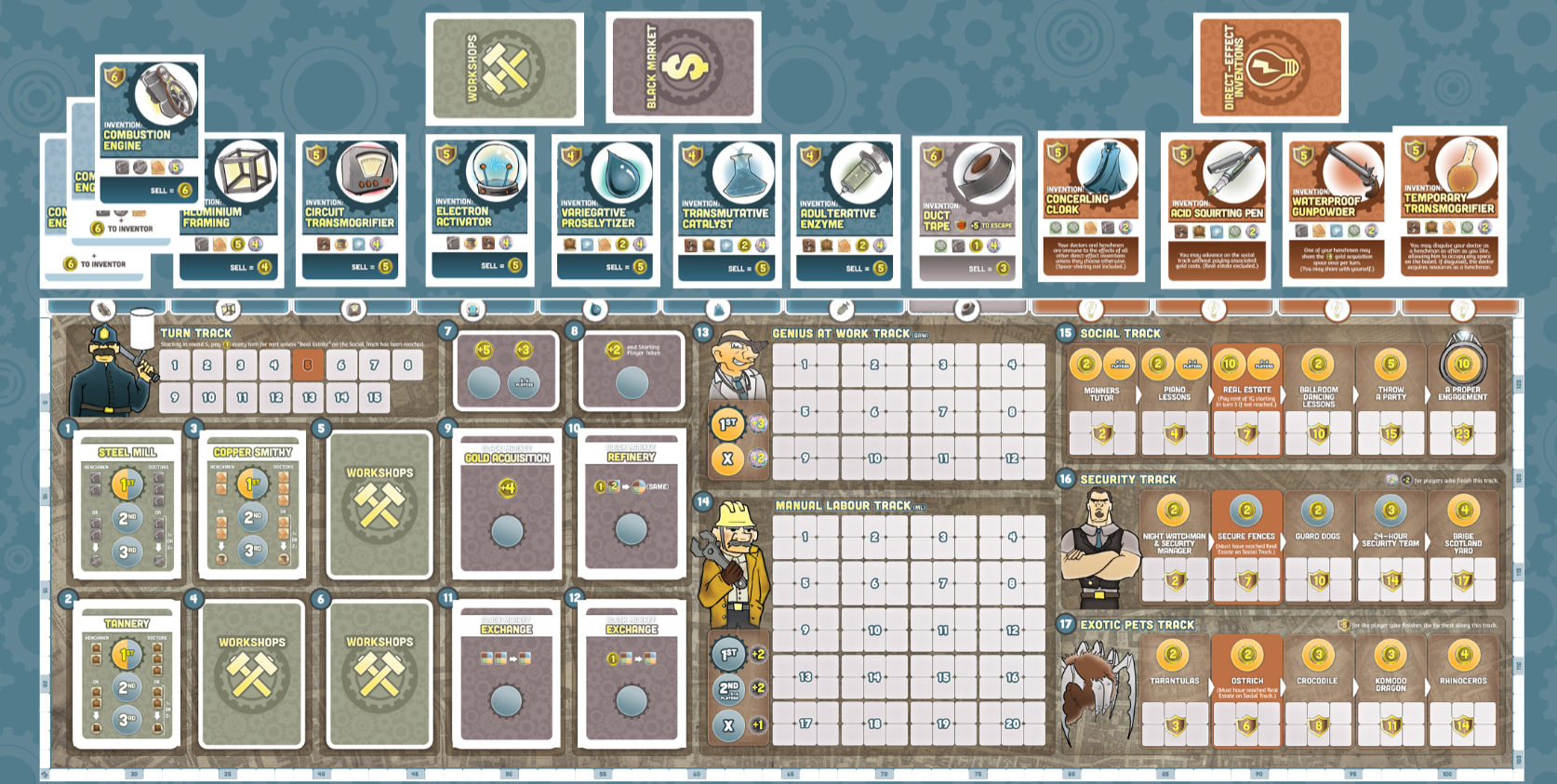Two weeks. That’s how long you’ve been on the job: a measly two weeks. It’s such a short period of time that you’re still waiting for your size jumpsuit to come in, and your locker still has the name Talbot on it instead of yours. Still, things could certainly be worse. You could still be doing amateur boxing at its meager payouts for one. Or you could have wound up like that Talbot bloke…what a way to go.
Nearing Tiger Bay, you nevertheless feel pangs of nervousness. Not because you’re worried about being in such the unsavory district, but rather the prospects of what could happen should you fail to return with all of your quarry. What the Boss wants with all of it you can’t say, but you know enough in your short time to not question him. Resolving to focus on the task at hand, you glance down at your list:
- Fifty pounds of copper wiring
- Vulcanized rubber (lots)
- A male gorilla or other non-draft animal of similar size
- One 12-inch spanner
- A sheet or sail of approximate ten cubic yards
- Two cases of dry gin — And DON’T take any, Talbot!
- 20 containers of petrol
Scanning it over, you shake your head briefly. Perhaps boxing was less dangerous to your health after all…
The Premise
It’s London in the late 1800’s, and players are putting their skills to use in the most calculating and nefarious ways possible. Players seek to unleash Doomsday Weapons upon the world – but they have to build them first. That takes time, resources, and manpower, all of which they have in limited supply. It is up to the players to see who can best make use of their background in Being Evil by assembling the most potent weapon, all the while trying to stay one step ahead of Scotland Yard.
The Rules
What’s He Building In There requires decent table space, as it is a pretty robust Worker Placement game, and players will also want to consult the full rules for all the finer details. In addition to the board, there are many card sets that correspond to different resources to acquire, Inventions to build, and actions that can be taken.
Each player receives four worker units: an Evil Doctor and three henchmen. Each player is also randomly given one Doomsday Weapon and one Escape Plan, which are combined to form a player screen. Weapons and Escape Plans contain three possible Stages of completion that a player may build to. Each Stage requires different resources, Inventions, and labor points that the player must possess at the end of the game to claim that Stage’s Victory Points. The higher the Stage reached, the more VP it’s worth.
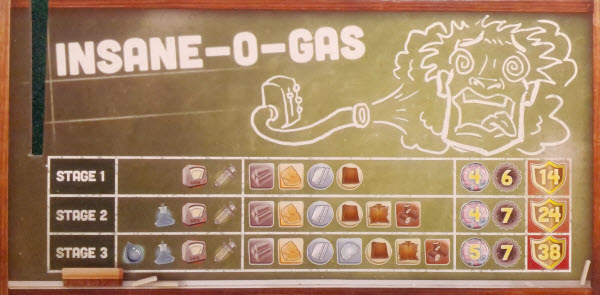
Each Stage to Insane-O-Gas requires more resources but comes with more VP.
The board is effectively broken up into three segments. The first segment deals with the acquisition of Gold and materials such as Glass and Copper. At the beginning of each round, four Black Market cards and a number of Workshop cards (equal to the number of players) are revealed, determining the available resource actions for that round. Workshop cards either provide raw resources or allow a player to refine them, whereas Black Market cards revolve around the buying, selling, and trading of those resources.
The second segment consists of two labor tracks, where points representing manpower are stored. The top section is the Evil Doctor’s Genius At Work (GAW) track, while the bottom is the henchmen’s Manual Labor (ML) track. These points are required to complete Inventions and the player’s project Stages.
The third segment consists of three progression tracks a player may invest in to accumulate VP through means other than via their projects.
 The game takes place over fifteen rounds, beginning with the player who last did something evil. (What that constitutes exactly is left to the players.) Starting with the first player, each person takes turns placing either their Evil Doctor or one of their henchmen on an action. Once all players have placed their workers, the action of each location is taken in order, starting with the Workshops and ending with the Exotic Pets track.
The game takes place over fifteen rounds, beginning with the player who last did something evil. (What that constitutes exactly is left to the players.) Starting with the first player, each person takes turns placing either their Evil Doctor or one of their henchmen on an action. Once all players have placed their workers, the action of each location is taken in order, starting with the Workshops and ending with the Exotic Pets track.
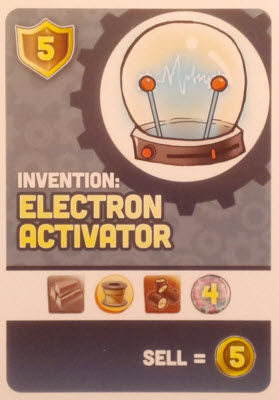
Next, players in turn order have the option to purchase an Invention, if able. In addition to fulfilling the requirements for a player’s project, building the first Invention of a specific kind also awards a player VP at the end of the game. Subsequent players inventing the same item can create it at a reduced resource cost but with no VP value.
Lastly, if the game has reached the fifth round and a player has not reached the Real Estate section of the Social track, that player is required to pay one gold to the supply in ‘rent’ each round until the game ends or they reach Real Estate.
At the end of fifteen rounds the game is over, and players reveal their glorious Doomsday Weapons and Escape Plans to the masses. Any player who has not stockpiled the necessary items to at least reach Stage One on both of their devices automatically loses. Otherwise, players total up the VP value of their devices, Inventions, and any points from the Social, Security and Exotic Pet tracks.
The player with the highest VP total has done the best job at being an evil genius and looses their creation upon the world. All other players must return to the drawing board and try again.

It’s a bit of a cliche setup, but don’t mess with a classic.
A Game With Brains…Over There On the Table
Right out of the box, two things are evident with What’s He Building in There. Firstly, this game plays up its theme well. Worker placement games are not particularly known for having intricate themes, but this game bucks that trend. Not only does the artwork accurately represent what you’d expect from a bunch of mad scientists, but the mechanics further reinforce the idea. (The Evil Doctor meeple is also a nice touch.)
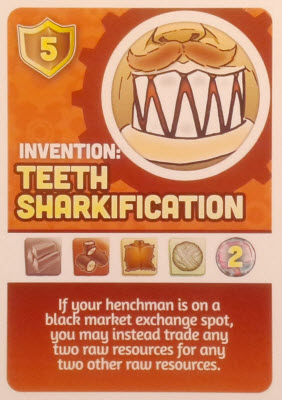
Look at those chompers.
Aside from the materials needed for your project, the game also lets you address the question, “What kind of mad scientist do you want to be?”
Would you like to focus entirely on making the biggest, baddest Doomsday Weapon around, or would you prefer to be more cavalier about it, such as focusing on a lower Stage device in exchange for acquiring a public presence in the Social Track or accentuating your eccentricity via the Exotic Pets Track? You cannot do everything. Yet all these options afford the player equally viable paths to victory, illustrating a well-done integration of theme into a game style not renown for it.
It’s not surprising that Immersionists who enjoy a dash of madness will approve of this game. What is surprising, however, is that Daredevils – known to avoid the structured trappings of worker placement games – may actually find enough variations in this one to be palatable. After all, who doesn’t want their own Komodo Dragon?
Too Busy For Pleasantries
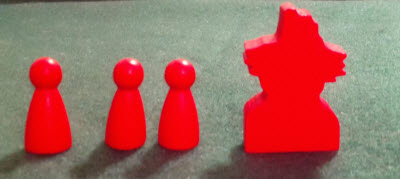
They’re up to no good.
Secondly, it’s evident that What’s He Building In There is not a lightweight worker placement game. Even with only four workers, there are numerous choices to be made every round in order to accomplish your goals. Attaining the necessary resources to even reach Stage One is not an easy endeavor. It can seem like a daunting task trying to accumulate it all, and early on it might seem like enough there’s not time to get there. Truthfully, it might not be. You are competing with other players for limited actions, and it can be a close call right up to your final turn.
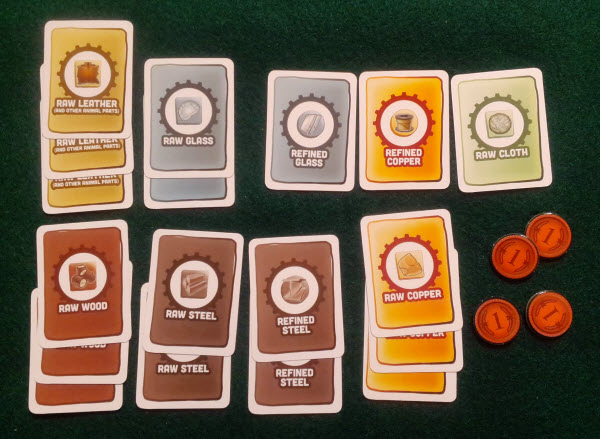
One example of the volume of resources just to reach Stage One
That said, while the game can initially feel intimidating, it actually runs fairly seamlessly. It’s certainly a complex worker placement game, but it isn’t incredibly complicated to understand once you get initiated. The printed rules are laid out very well, and there’s little need to have to reference them much after an initial playthrough.
 Moreover, unlike other worker placement games, What’s He Building downplays taking actions to simply block other players. Since each player’s projects are secret until the end of the game, you don’t quite know what other players are after most the time. Cutting someone off is still an option, but it’s not an incredibly useful tactic. As an Evil Doctor, your focus is more on your own world-domination plans (and the time and resource management that goes with it) than mucking with others. Thus, this tonal change will likely not appeal to Strikers, and this is precisely the type of hefty game that Socializers should avoid. On the other hand, this is undoubtedly an ideal worker placement game for Architects.
Moreover, unlike other worker placement games, What’s He Building downplays taking actions to simply block other players. Since each player’s projects are secret until the end of the game, you don’t quite know what other players are after most the time. Cutting someone off is still an option, but it’s not an incredibly useful tactic. As an Evil Doctor, your focus is more on your own world-domination plans (and the time and resource management that goes with it) than mucking with others. Thus, this tonal change will likely not appeal to Strikers, and this is precisely the type of hefty game that Socializers should avoid. On the other hand, this is undoubtedly an ideal worker placement game for Architects.
Five Minutes to Midnight
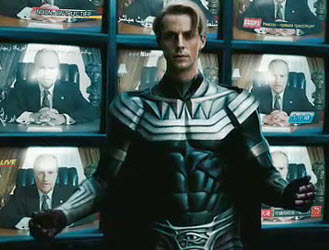
“I did it thirty-five minutes ago.”
That all said, all of this complexity comes with some costs. The most pressing of these is the time factor: the game accurately states about a half hour per person. With five or six players, it is certainly one of the longer worker placement games out there.
More pressingly, though, is that it’s possible to experience a tapering of enthusiasm if the game drags on too long. Worker placement by their nature are not terribly full of in-game interaction. Their appeal is in players testing their puzzle-solving acumen against one another. Normally, there is enough strategic decision-making and tactical maneuvering to keep players actively engaged until the game is over. However, if the game takes too long, that lack of interaction starts to diminish the game’s excitement. That can happen here around the 2.5-3 hour mark. As a result, What’s He Building In There works best with 3-5 players – save the 6-player option until your players have a few sessions under the belt.
Additionally, while the high degree of resource management creates a healthy and exciting tightness to the game, it also forces players to weigh the decisions of their current and future turns carefully. Aside from the changing Workshop and Black Market cards each round, there is very little luck in the game; every action can matter.
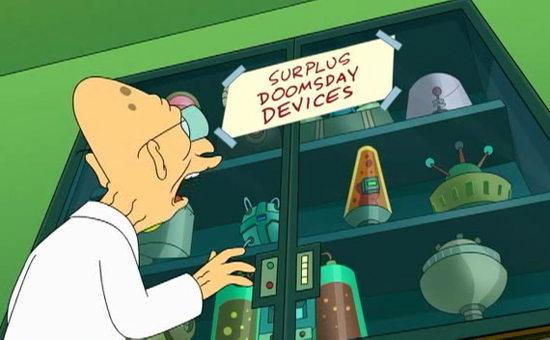
“I suppose I can part with one and still be feared.”
Indeed, whether you wind up with a Stage 3 Doomsday Weapon or not finishing it all can sometimes be quite close. With a mere four workers, which actions to take and the turn order have a direct impact on success. This depth of strategy is one of the game’s best attributes, and it will make your resident Tacticians quite happy. However, it also invites analysis paralysis – something else that group is prone to.
At the same time, it takes some effort to handle the necessary level of resource card management. How you organize them behind your player screen is entirely up to you, but it can be a little fiddly at times. A holder of some sort could have been useful to alleviate this, but this issue is minor. Nevertheless, between AP issues and having to continually re-evaluate your resource cards, you’ll want to factor those into your play time.
The Takeaway
There is no hiding the fact that What’s He Building In There? is on the heavier side of the worker placement spectrum. It may initially feel like there are too many spinning plates to be worthwhile, but once underway the game is pleasantly straightforward while allowing players to make strategic choices as to how they’d like to build VP. (No two evil geniuses are the same, after all.) The game can get a little long in the tooth with a table full of new players, and some of the resource art could be a little better defined to avoid confusion, but these factors are minor when compared to the number of things the game does exceedingly well. From taut gameplay to campy flavor, What’s He Building In There provides a thematically functional worker placement game that doesn’t feel tacked on or too linear, proving to be a solid addition to the genre. If you’re up for the challenge of doing some mad science, then step into the lab and find out the answer to the question, “Hey, what’s he building in there?”
What’s He Building In There? is a product of Baksha Games.
Cardboard Republic Snapshot Scoring (Based on scale of 5):
Artwork: 4
Rules Clarity: 4.5
Physical Quality: 4
Replay Value: 4
Overall Score: 4
Photo Credits: Syndrome by Pixar Studios; Dr. Horrible by Mutant Enemy Productions; Ozymandias by Warner Bros. Entertainment; Futurama by 20th Century Fox.

